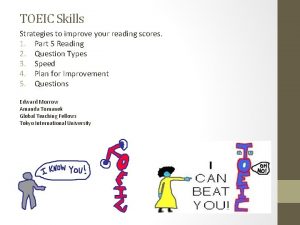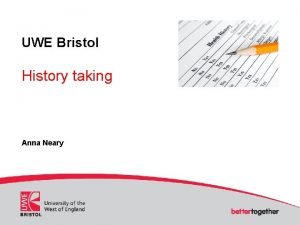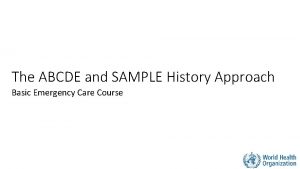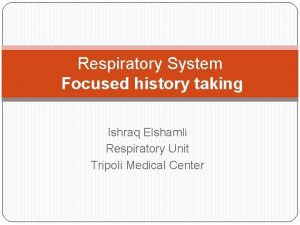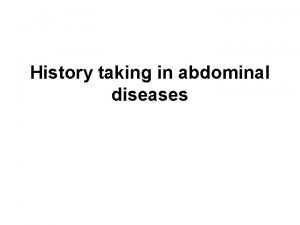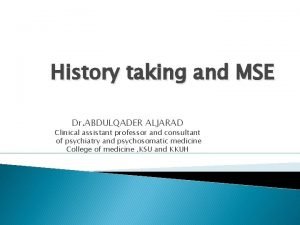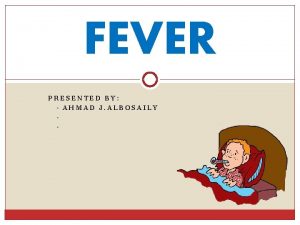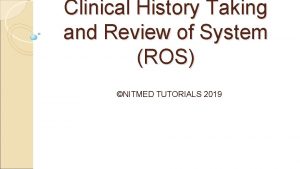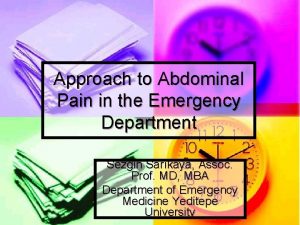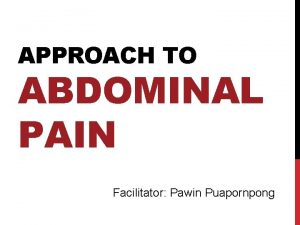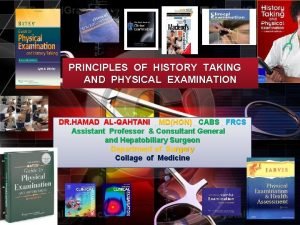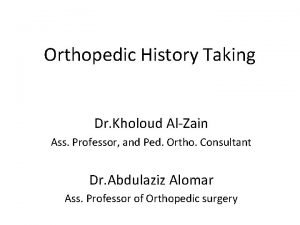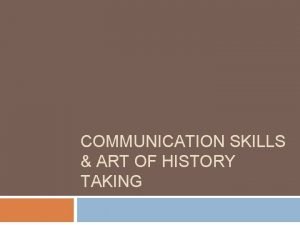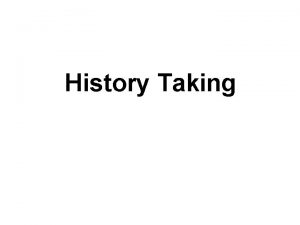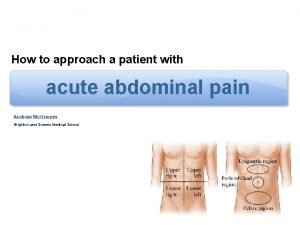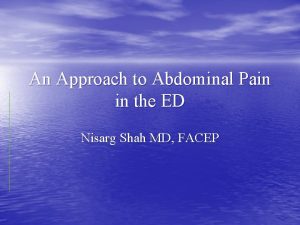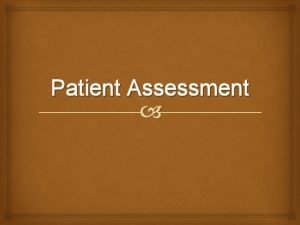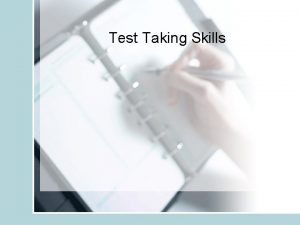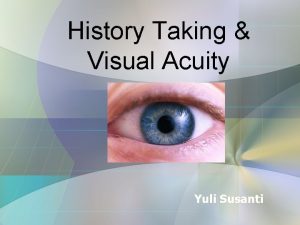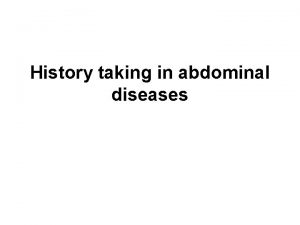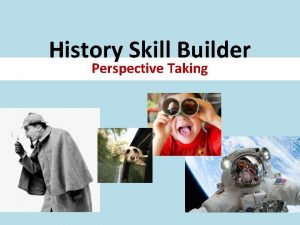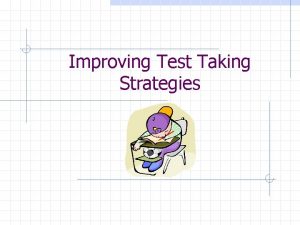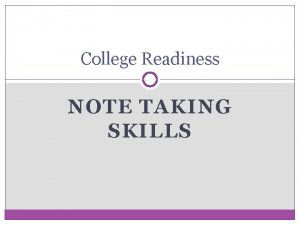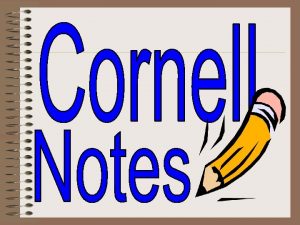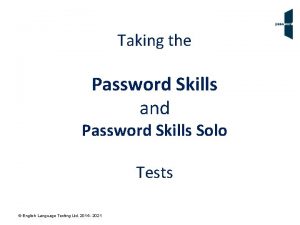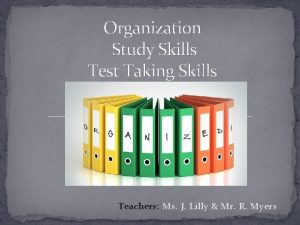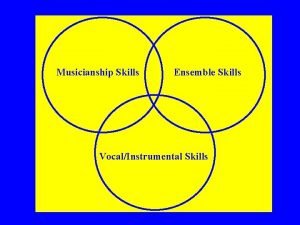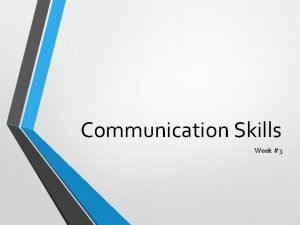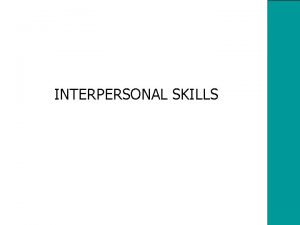ORTHOEADIC HISTORY TAKING History taking skills History taking
























- Slides: 24

ORTHOEADIC HISTORY TAKING

History taking skills • History taking is the most important step in making a diagnosis. • A clinician is 60% closer to making a diagnosis with a thorough history. The remaining 40% is a combination of examination findings and investigations. • History taking can either be of a traumatic or non traumatic injury.

Objective • At the end of this session, students should know how and be able to take a MSK relevant history.

Competency expected from the students • Take a relevant history, with the knowledge of the characteristics of the major musculoskeletal conditions

STRUCTURE OF HISTORY • Demographic feature • Chief complaint • History of presenting illness • MSK systemic review • Systemic enquiry • PMH • PSH • • • Drug Hx Occupational Hx Allergy Family Hx Social Hx

MSK systemic review • • • Pain Stiffness Swelling Instability Deformity Limp Altered Sensation Loss of function Weakness

Pain • Location – Point to where it is • Radiation – Does the pain go anywhere else • Type – Burning, sharp, dull • How long have you had the pain • How did it start – Injury • Mechanism of injury • How was it treated? – Insidious

Pain • Progression – Is it getting worse or is it remaining stable – Is it better, worse or the same • When – Mechanical / Walking – Rest – Night – nocte – Constant • Aggravating & Relieving Factors – Stairs – Start up, mechanical – Pain with twisting & turning – Up & down hills – Kneeling – Squatting

Pain • • • Where: location/radiation When: onset/duration WWQQAA Quality: what it feels like Quantity: intensity, degree of disability Aggravating and Alleviating factors Associated symptoms

Swelling • • Duration Local vs generalised Associated with injury or reactive Soft tissue, joint, bone Rapidly or slowly Painful or not Constant or comes and goes Progression: same size or↑

Instability • • • Frequency Trigger/aggravated factors Giving way Buckling 2 dary to pain I can trust my leg! Associated symptoms – Swelling – Pain

Deformity • • Associated with pain & stiffness When did you notice it? Progressive or not? Impaired function or not? Associated symptoms Past Hx of trauma or surgery PMHx (neuromuscular, polio…etc)

Limping • • Painful vs painless Onset (acute or chronic) Progressive or not? Use walking aid? Functional disability? Traumatic or non traumatic? Associated with swelling, deformity, or fever.

Loss of function • How has this affected your life • Home (daily living activities DLA) – Prayer – Using toilet – getting out of chairs / bed – socks – stairs – squat or kneel for gardening – walking distance – get & out of cars • Work • Sport – Type & intensity – Run, jump

Mechanical symptoms Locking / clicking • Loose body, meniscal tear • Locking vs pseudo locking Giving way • Buckling 2° pain • ACL • Patella

Red flags • • • Weight loss Fever Loss of sensation Loss of motor function Difficulties with urination or defecation

Risk factors Age Gender Obesity Lack of physical activity Inadequate dietary calcium and vitamin D • Smoking • • • Occupation and Sport, Family History (SCA) Infections, Medication (steroid) Alcohol PHx Musculoskeletal injury/condition, • PHx Cancer • • •

Treatment • Nonoperative – Medications • Analgesia • How much • How long – Physio – Orthotics • Walking sticks • Splints • Operative

Spine • Pain – radiation exact location • L 4 • L 5 • S 1 – Aggrevating, relieving Hills • Neuropathic » extension & walking downhill » ¯ walking uphill & sitting • vascular » walking uphill • generates more work » ¯ rest • standing is better than sitting due to pressure gradient – stairs – shopping trolleys – coughing, straining – sitting – forward flexion

Spine • Associated symptoms – Paresthesia – Numbness – Weakness • L 4 • L 5 • S 1 – Bowel, Bladder – Cervical myelopathy • Clumbsiness of hand • Unsteadiness • Manual dexterity • Red Flags – – – Loss of weight Constitutional symptoms Fevers, sweats Night pain, rest pain History of trauma immunosuppresion

• Age of the patient – Younger patients shoulder instability and acromioclavicular joint injuries are more prevalent – Older patients rotator cuff injuries and degenerative joint problems are more common • Mechanism of injury – Abduction and external rotation dislocation of the shoulder – Direct fall onto the shoulder acromioclavicular joint injuries – Chronic pain upon overhead activity or at night time rotator cuff problem.

Shoulder • Pain • Where – Rotator Cuff • anterolateral & superior • deltoid insertion – Bicipital tendonitis • Referred to elbow • Aggravating / Relieving factors – Position that ↑ symptoms • RC: Window cleaning position • Instability: when arm is overhead – Neck pain • Is shoulder pain related to neck pain • ask about

• Causes – AC joint – Cervical Spine – Glenohumeral joint & rotator cuff • Front & outer aspect of joint • Radiates to middle of arm – Rotator cuff impingement • Positional : appears in the window cleaning position – Instability • Comes on suddenly when the arm is held high overhead – Referred pain • Mediastinal disorders, cardiac ischaemia

Shoulder • Associated – Stiffness – Instability / Gives way • Severe – feeling of joint dislocating • Usually more subtle presenting with clicks/jerks • What position • Initial trauma • How often • Ligamentous laxity – Clicking, Catching / grinding • If so, what position – Weakness • Rotator cuff – especially if large tear – Pins & needles, numbness • Loss of function – Home • Dressing – Coat – Bra • Grooming – Toilet – Brushing hair • Lift objects • Difficulty working with arm above shoulder height – Top shelves – Hanging washing – Work – Sport
 Test taking skills for middle school
Test taking skills for middle school Taking the toeic skills and strategies 1
Taking the toeic skills and strategies 1 Note taking skills
Note taking skills Interpersonal communication vs intrapersonal
Interpersonal communication vs intrapersonal What are hard skills
What are hard skills Essential skills ontario
Essential skills ontario Systematic review in history taking
Systematic review in history taking Abcde ample
Abcde ample History taking respiratory system
History taking respiratory system Paediatric history osce scenarios
Paediatric history osce scenarios Ascites mnemonic
Ascites mnemonic Mse history taking
Mse history taking Fever history
Fever history Odpara history taking
Odpara history taking Hypogastric pain causes
Hypogastric pain causes Lodcraft pain
Lodcraft pain Principles of physical examination
Principles of physical examination Orthopedic history
Orthopedic history History taking paediatrics
History taking paediatrics The art of history taking
The art of history taking History components
History components Systemic review
Systemic review Abdominal pain socrates
Abdominal pain socrates Lodcraft history taking
Lodcraft history taking History taking
History taking

